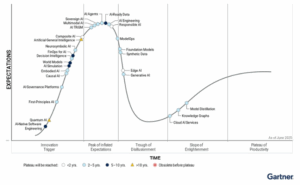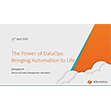
AI Hype Cycle: Gartner Charts the Rise of Agents, ModelOps, Synthetic Data, and AI Engineering

(Dave Hoeek/Shutterstock)
Gartner says the average company spent around $1.9 million on GenAI last year, yet fewer than 30% of AI leaders think their CEOs are satisfied with the results. That gap between spending and satisfaction is concerning.
After a stretch of buzz and experimentation, business leaders are moving past flashy demos and proof-of-concept hype. They’re asking harder questions now. What can AI really do inside a complex business? What works at scale, and what breaks when real-world systems get involved?
You can see that shift clearly in Gartner’s latest Hype Cycles for Artificial Intelligence and Generative AI. These reports chart the maturity, adoption, and business impact of emerging AI technologies. One of the key findings is that while GenAI by itself still holds a prominent place, it’s no longer the main event. As its limits become more visible, attention is shifting to the things that actually make GenAI usable, such as better data, smarter workflows, and stronger governance.
Despite the early excitement, a lot of GenAI efforts are stalling out. Gartner found that only 43% of organizations say their data is ready for AI. That alone can grind projects to a halt. Even the best models can fall short when the surrounding systems are messy. Weak data quality and disconnected infrastructure can quietly wreck results. Many teams don’t yet have the skills or rules in place to manage GenAI once it’s deployed. Fewer than half have formal policies to track access, usage, or accountability.
Gartner’s Hype Cycle reflects that tension. GenAI now sits in the Trough of Disillusionment. That is a sign that the technology remains powerful, but the expectations are cooling. Companies are realizing that value doesn’t just come from building a model. It comes from readiness, trust, and real integration.
That’s why ModelOps and AI engineering are climbing. ModelOps brings structure to the messy business of managing AI across its lifecycle. AI engineering is about giving teams the tools and systems they need to deploy at scale without losing control. These used to be side conversations. Now they’re front and center.
Two categories are rising faster than the rest: AI-ready data and AI agents. Agents are getting attention because they don’t just respond to prompts. They can carry out multistep tasks with a degree of independence. That’s exciting, but it also comes with risks. Gartner points to growing concerns about mistakes, oversight, and data security when agents act on their own.
The same urgency is driving interest in data readiness. More than 50% of the leaders admit their data isn’t where it needs to be. Having a lot of it isn’t enough. The data has to be reliable, usable, and safe. When it’s not, companies face real risks, such as missed targets, poor decisions, and compliance problems. That’s why data infrastructure is becoming a top priority.
Other technologies are picking up speed too. Multimodal AI is one of them. These models can work across text, images, video, and audio, which opens up a wide range of new applications. And trust is becoming a central theme. Businesses are under pressure to ensure AI decisions are fair, secure, and explainable. Gartner groups these efforts under AI TRiSM, and while the space is still early, the shift toward accountability is clear.
Meanwhile, some GenAI-adjacent trends are already losing steam. Prompt engineering is fading as tools get better at understanding plain language. Model marketplaces are also cooling off, with companies moving away from off-the-shelf options. Even GenAI for code generation, which once seemed like a breakthrough, is starting to face real-world friction.
At the same time, Gartner flags some newer ideas that are gaining traction. Synthetic data, although not a new idea, is becoming more valuable, especially in fields like healthcare and finance, where real-world data is hard to access. Emotion AI is showing up in customer support and wellness tools, though people still worry about how accurate or fair it is. These aren’t the flashiest technologies yet, but the momentum is building around them. As GenAI becomes more routine, the attention is turning to the ecosystem that makes it work or fail.
Some shifts are quieter but just as important. Companies are starting to use LLMOps and AgentOps to manage the complexity that comes with scaling large models and autonomous agents. These newer practices help teams monitor, tune, and maintain systems that don’t behave like traditional software. At the same time, tools like vector databases and data fabric are becoming key for building data pipelines that can keep up.
Gartner also points to early-stage techniques like composite AI, causal AI, and neuro-symbolic AI. These methods aim to bring more logic, structure, and context into how AI systems think and decide. While some areas are heating up, others have faded from the chart. AI cloud services, for instance, are no longer treated as cutting-edge. They still matter, but they’re part of the background now.
What the Gartner reports show is that the future of enterprise AI will depend on how well organizations can rebuild the foundation beneath it. The data, governance, systems, and trust. That’s the real arc of the Hype Cycle, and also the real challenge ahead.
Related Items
Our Shared AI Future: Industry, Academia, and Government Come Together at TPC25
Why You Don’t Need a Chief AI Officer, Now or Likely Ever. Here’s What to Do Instead
Can We Learn to Live with AI Hallucinations?









































